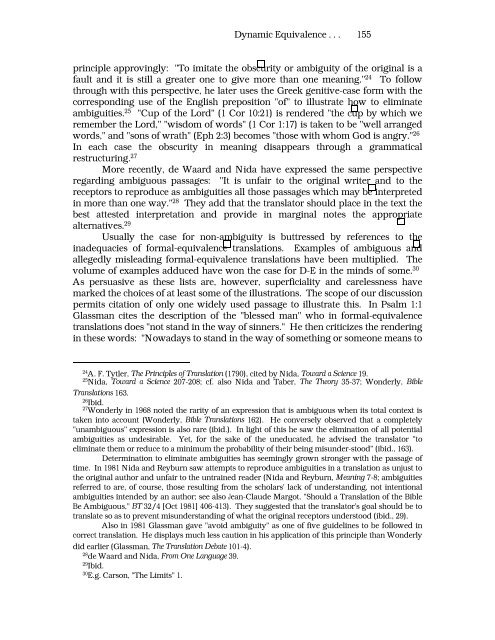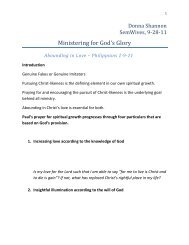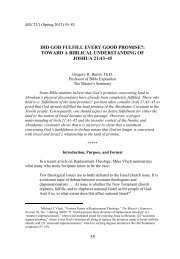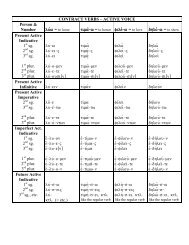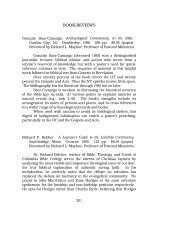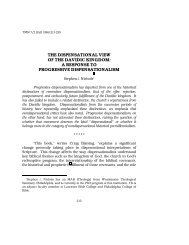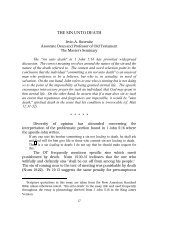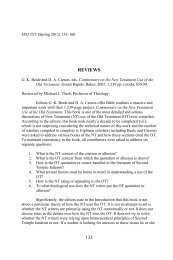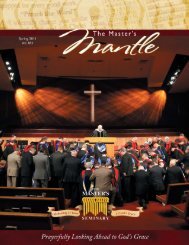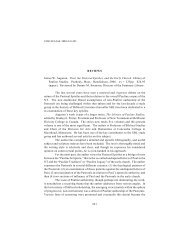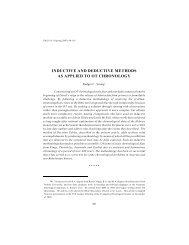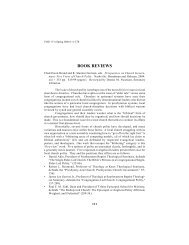dynamic equivalence: a method of translation or a system
dynamic equivalence: a method of translation or a system
dynamic equivalence: a method of translation or a system
- No tags were found...
You also want an ePaper? Increase the reach of your titles
YUMPU automatically turns print PDFs into web optimized ePapers that Google loves.
Dynamic Equivalence . . . 155principle approvingly: "To imitate the obscurity <strong>or</strong> ambiguity <strong>of</strong> the <strong>or</strong>iginal is afault and it is still a greater one to give m<strong>or</strong>e than one meaning." 24 To followthrough with this perspective, he later uses the Greek genitive-case f<strong>or</strong>m with thec<strong>or</strong>responding use <strong>of</strong> the English preposition "<strong>of</strong>" to illustrate how to eliminateambiguities. 25 "Cup <strong>of</strong> the L<strong>or</strong>d" (1 C<strong>or</strong> 10:21) is rendered "the cup by which weremember the L<strong>or</strong>d," "wisdom <strong>of</strong> w<strong>or</strong>ds" (1 C<strong>or</strong> 1:17) is taken to be "well arrangedw<strong>or</strong>ds," and "sons <strong>of</strong> wrath" (Eph 2:3) becomes "those with whom God is angry." 26In each case the obscurity in meaning disappears through a grammaticalrestructuring. 27M<strong>or</strong>e recently, de Waard and Nida have expressed the same perspectiveregarding ambiguous passages: "It is unfair to the <strong>or</strong>iginal writer and to therecept<strong>or</strong>s to reproduce as ambiguities all those passages which may be interpretedin m<strong>or</strong>e than one way." 28 They add that the translat<strong>or</strong> should place in the text thebest attested interpretation and provide in marginal notes the appropriatealternatives. 29Usually the case f<strong>or</strong> non-ambiguity is buttressed by references to theinadequacies <strong>of</strong> f<strong>or</strong>mal-<strong>equivalence</strong> <strong>translation</strong>s. Examples <strong>of</strong> ambiguous andallegedly misleading f<strong>or</strong>mal-<strong>equivalence</strong> <strong>translation</strong>s have been multiplied. Thevolume <strong>of</strong> examples adduced have won the case f<strong>or</strong> D-E in the minds <strong>of</strong> some. 30As persuasive as these lists are, however, superficiality and carelessness havemarked the choices <strong>of</strong> at least some <strong>of</strong> the illustrations. The scope <strong>of</strong> our discussionpermits citation <strong>of</strong> only one widely used passage to illustrate this. In Psalm 1:1Glassman cites the description <strong>of</strong> the "blessed man" who in f<strong>or</strong>mal-<strong>equivalence</strong><strong>translation</strong>s does "not stand in the way <strong>of</strong> sinners." He then criticizes the renderingin these w<strong>or</strong>ds: "Nowadays to stand in the way <strong>of</strong> something <strong>or</strong> someone means to24A. F. Tytler, The Principles <strong>of</strong> Translation (1790), cited by Nida, Toward a Science 19.25Nida, Toward a Science 207-208; cf. also Nida and Taber, The The<strong>or</strong>y 35-37; Wonderly, BibleTranslations 163.26Ibid.27Wonderly in 1968 noted the rarity <strong>of</strong> an expression that is ambiguous when its total context istaken into account (Wonderly, Bible Translations 162). He conversely observed that a completely"unambiguous" expression is also rare (ibid.). In light <strong>of</strong> this he saw the elimination <strong>of</strong> all potentialambiguities as undesirable. Yet, f<strong>or</strong> the sake <strong>of</strong> the uneducated, he advised the translat<strong>or</strong> "toeliminate them <strong>or</strong> reduce to a minimum the probability <strong>of</strong> their being misunder-stood" (ibid., 163).Determination to eliminate ambiguities has seemingly grown stronger with the passage <strong>of</strong>time. In 1981 Nida and Reyburn saw attempts to reproduce ambiguities in a <strong>translation</strong> as unjust tothe <strong>or</strong>iginal auth<strong>or</strong> and unfair to the untrained reader (Nida and Reyburn, Meaning 7-8; ambiguitiesreferred to are, <strong>of</strong> course, those resulting from the scholars' lack <strong>of</strong> understanding, not intentionalambiguities intended by an auth<strong>or</strong>; see also Jean-Claude Margot, "Should a Translation <strong>of</strong> the BibleBe Ambiguous," BT 32/4 [Oct 1981] 406-413). They suggested that the translat<strong>or</strong>'s goal should be totranslate so as to prevent misunderstanding <strong>of</strong> what the <strong>or</strong>iginal recept<strong>or</strong>s understood (ibid., 29).Also in 1981 Glassman gave "avoid ambiguity" as one <strong>of</strong> five guidelines to be followed inc<strong>or</strong>rect <strong>translation</strong>. He displays much less caution in his application <strong>of</strong> this principle than Wonderlydid earlier (Glassman, The Translation Debate 101-4).28de Waard and Nida, From One Language 39.29Ibid.30E.g. Carson, "The Limits" 1.


